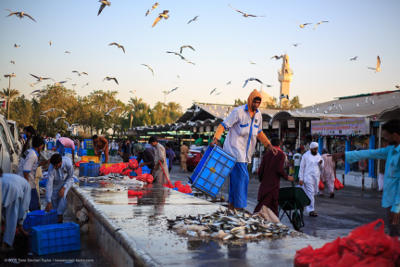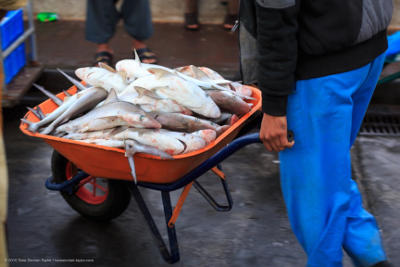Using AI to control energy for indoor agriculture
30 September 2024
Published online 15 October 2015
Overfishing is unbalancing the region’s coral reef habitats by culling their top predators.

© Tane Sinclair-Taylor/ Red
Sea Research Center/ KAUST
“The reefs looked like they were in great shape, but there was something missing,” says Berumen. “Every single one we visited had small groupers, snappers, and trevallies, but not bigger ones, and we didn’t see any sharks. It didn't take us long to realize that the top predators were gone.”
Now director of the Reef Ecology Lab at KAUST, Berumen has studied these fish and coral populations ever since, using GPS and acoustic tagging to track the movements of sharks, rays, and other large predators, and genomic techniques to catalogue and determine the evolutionary relationships of the species they find.
“Fishing pressure seems to be fairly widespread and the shark populations can’t handle it,” he says. “They reproduce slowly, don’t have many babies, and take a long time to grow.”
Often referred to as the rainforests of the ocean, coral reefs sustain more than a quarter of the world's marine species, despite taking up less than 1% of the sea surface. Coral reefs in the Red Sea, like those elsewhere, have been in sharp decline over the past 15 years, and it is now estimated that nearly two-thirds of the reefs in the region are under threat.
This is due in part to the region’s tourism, oil industry, and also by climate change, disease, and pollution. Overfishing is another major factor that threatens the Middle East’s coral reefs – one which may already have caused irreparable damage to the ecosystem.
Population growth has led to a rising demand for fish as a food source, and poor regulation coupled with more rapacious fishing practices has led to an overall decline in marine populations, with deep-water commercial fish species in particular severely affected.

© Tane Sinclair-Taylor/ Red Sea Research Center/ KAUST
“Even though sharks make up a much smaller proportion of fishing hauls than groupers or snappers, it's still a heavy burden on the shark population, and the Saudi Red Sea, at least, does not seem to be able to handle this,” says Berumen.
Julia Spät, a former Ph.D. student in Berumen's lab, recently conducted a two-year survey of the shark species on sale at the Jeddah fish market1. “I visited the market 48 times and collected a total of 2,561 specimens belonging to 23 species,” she says, adding that five species – the spot-tail shark, grey reef shark, silky shark, blacktip shark and milk shark – dominated the landings, together comprising nearly three quarters of the total shark catch.
“Despite a 2008 royal decree prohibiting all shark fishing activities in Saudi Arabian Red Sea waters, large numbers of sharks are [still being] landed on a daily basis,” she adds
Importantly, Spät's research also revealed that the majority of landed sharks were sexually immature males and females. “This emphasises the urgent need to implement region-specific management and conservation strategies to avoid the loss of these critical predators,” she says.
In Sudanese waters, by contrast, shark fishing seems to be more sustainable. “Many in Sudan can't afford to buy fish or go fishing, so there isn't much of a fishing industry,” says Berumen. “Tourism operators there also do a very good job of making sure that people don't fish for sharks, so Sudan may provide a glimpse as to what reefs could look like if the human impact was removed.”
As Berumen and his colleagues have observed, overfishing can remove entire groups of fish from the reef ecosystem. But the practice is not limited to large predators, and overfishing of other species can impact reefs in different ways.
Several years ago, Christian Voolstra of KAUST's Reef Genomics Lab and colleagues, collaborating with researchers in Bremen, Germany, conducted several studies that attempted to simulate the effects of overfishing on the Red Sea's coral reefs over a four-month period.
They found that excluding herbivores from a section of reef near the coastal city of Thuwal increased the dry mass of algae up to 300-fold, and significantly altered the bacterial diversity and physiology of the corals2. These results suggest that overfishing has a domino effect that trickles down the food chain and may rapidly alter the composition of corals if not controlled.
“Herbivores are like the lawnmowers of the reef, and without them reefs can get overgrown with algae and weeds,” says Berumen. “Normally, corals out-compete algae, but if the ecosystem lacks herbivores, algae can suddenly become dominant, making it very hard for corals to get re-established if the system is disturbed.”
While it is clear that overfishing is having detrimental effects on Red Sea corals, it's impossible to know the extent to which fish stocks are being over-exploited, because there are no baseline data about how abundant the species were in the past.
The system is in a fragile state right now.
In recent years, conservationists have been campaigning against overfishing in the region, and political leaders in the Gulf Cooperation Countries are becoming aware of the problems. In 2012, for example, the United Arab Emirates, the world's fourth largest exporter of raw dried shark fins, introduced new laws aimed at preventing shark overfishing.
While overfishing of many of the affected species could be managed at the local or national level, it seems that the shark overfishing problem can only be solved by the concerted efforts of governments across multiple countries.
“I’m worried that the system is in a fragile state right now,” says Berumen. “We know that sharks can move long distances, and we've tracked whale sharks moving all around the Red Sea, so we’re all going to have to work together on this issue.”
According to Spät, the situation may be difficult to reverse. “Most shark populations in the Red Sea have collapsed, and I think the only way to reverse the effects for at least some species would be to stop shark fisheries completely for an extended period” she says. “There is an apparent lack of political will and a general dearth of public awareness preventing the implementation of effective management plans.”
The Red Sea is the world's second most biodiverse hotspot, and its reefs are unique in that they inhabit a hyper-arid, sub-tropical region with highly salty waters.
Berumen believes that learning more about the ecology and biology of Red Sea corals could be underpin attempts to understanding the effects of global warming on corals in other parts of the world. “The water here is much hotter and more saline than in other places,” he says, “so if you took coral from Australia’s Great Barrier Reef and dropped it into the Red Sea, it would probably bleach and die.”
doi:10.1038/nmiddleeast.2015.192
Stay connected: